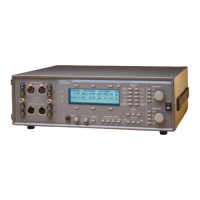For record bias adjustments by the overbias technique, use LEVEL
mode with dBr units. Set the generator to 10 kHz at 20 dB below
normal line level. Start with the recorder bias control at minimum and
slowly increase it while looking for a maximum output on the channel
being adjusted. When the maximum is found, press the dBr ZERO
button. Then, further increase the bias until the level decreases by the
specified amount of overbias for the tape type and tape speed in use.
Repeat this process for the alternate channel.
The record head azimuth alignment should be re-checked after
adjusting bias, since the effective azimuth angle depends both upon
the mechanical azimuth and the amount of bias current in the head. It
may be necessary to repeat bias and azimuth adjustments more than
once to arrive at the final correct values.
For record treble level (equalization) adjustment, LEVEL function with
dBr units is the most convenient. A bargraph display with end points
of perhaps +5 and -5 dBr is convenient. The generator output should
be set 20 dB below normal line level to avoid any possible tape
saturation effects. It is convenient to use the x10 and ÷10 frequency
buttons to instantly change the generator frequency from a midband
reference frequency to a high-frequency value. For example, the
generator can be set to 1 kHz, then quickly changed between 1 kHz
and 10 kHz with these buttons while adjusting record treble
equalization for equal output at the midband and high frequency. It is
also possible to set up a repeating 3-step sweep from 15 or 20 kHz to
1 kHz as described above under record head azimuth adjustment, but
in LEVEL function to display response of both channels. Press and
hold the SWEEP button until the first measurement point is displayed
numerically at the left of the display to start the repeating sweep cycle.
Now, the treble equalization may be adjusted on both channels for the
best compromise between flat frequency response and extended
high-frequency response.
For a final frequency response verification following alignment,
change the sweep parameters for a higher-resolution sweep (30 step is
typical) across the entire audio band. The resulting graph may be
printed for permanent documentation of recorder performance.
For k3 (third harmonic) distortion measurements such as when
measuring MOL (maximum output level), install an optional bandpass
5 Applications
Analog Tape Recorder Alignment and Performance Verification Applications Notes
5-4 ATS-1 Dual Domain User's Manual

